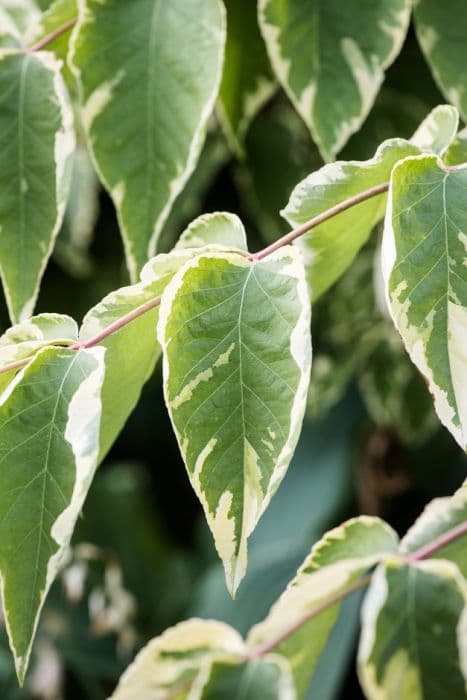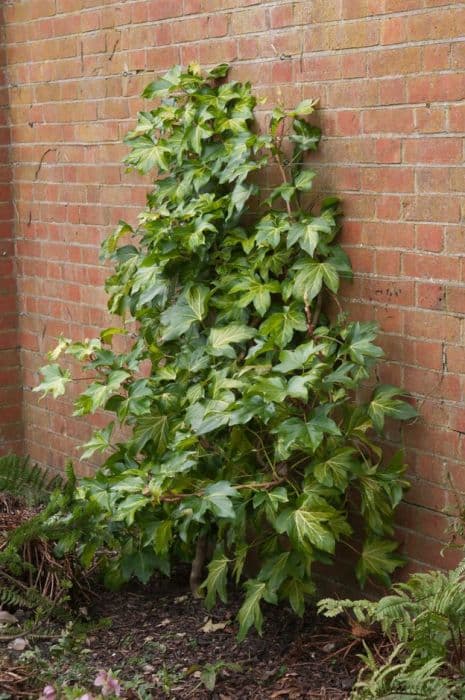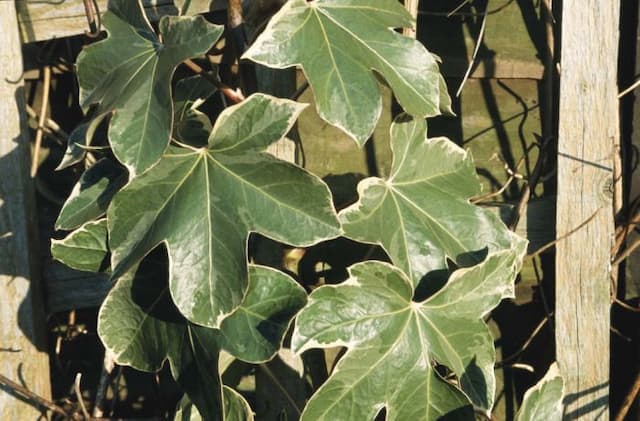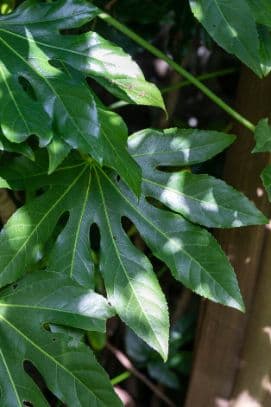Seven Finger Pseudopanax (Adiantifolius Group) 'Cyril Watson'
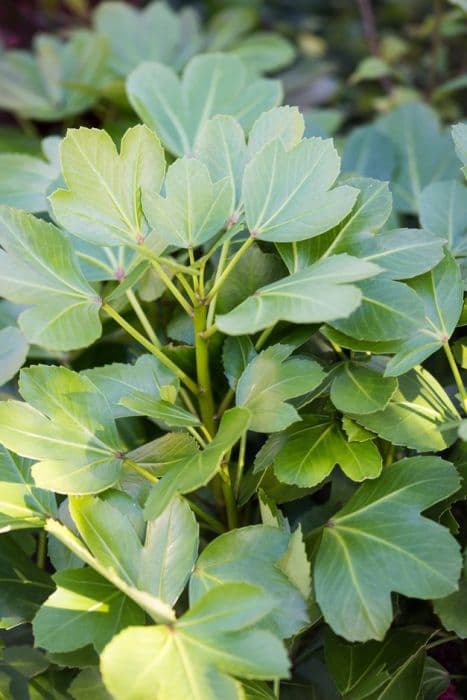
ABOUT
The Pseudopanax 'Cyril Watson' is a visually striking plant known for its unique foliage. This specimen sports lush green leaves that are often divided into multiple leaflets, each resembling a slender and elongated version of these typically broad-leafed plants. The leaves are generally arranged in a radial pattern, which emanates from the center of the leaf stem, creating an attractive, palmate look that is both intricate and eye-catching. Each leaflet has a slightly toothed or jagged edge that adds a textured appearance to the foliage. Depending on the maturity of the plant, the leaflets can vary in number, but they typically create a full, bushy aspect, radiating outwards, which can provide a dense and lush aesthetic to the garden or container in which the plant resides. The color of the leaves is a deep green, sometimes with a glossy sheen that catches the light and highlights the serrations on the leaf margins. In addition to the plant's noteworthy leaves, it may also produce inconspicuous flowers in the right conditions, which further contribute to its decorative appeal. However, the primary visual interest comes from its foliage. The Pseudopanax 'Cyril Watson' contributes a sophisticated and dramatic touch to spaces with its fine leaf structure and alluring green canopy.
About this plant
 Names
NamesFamily
Araliaceae.
Synonyms
None available.
Common names
Pseudopanax adiantifolius 'Cyril Watson'
 Toxicity
ToxicityTo humans
The Pseudopanax 'Cyril Watson', commonly known as Lancewood, is not widely documented as a toxic plant to humans. There is limited information available on its toxicity, and it is not known to be a common cause of poisoning. However, as with many plants, individual sensitivity can vary, and some people might experience mild stomach upset or dermatitis from handling or ingesting the plant. If you suspect poisoning, it is important to seek medical advice.
To pets
Lancewood is not widely known to be toxic to pets. There is limited information available suggesting that the Pseudopanax 'Cyril Watson' causes toxicity in animals. However, as a general precaution, it is advisable to prevent pets from ingesting any part of the plant, since individual animals can have different sensitivities and reactions to various plants. If you notice any unusual symptoms in your pet after ingestion, such as vomiting or diarrhea, contact your veterinarian.
 Characteristics
CharacteristicsLife cycle
Perennials
Foliage type
Evergreen
Color of leaves
Green
Height
8-10 feet (2.4-3 meters)
Spread
5-6 feet (1.5-1.8 meters)
Plant type
Shrub
Hardiness zones
9
Native area
New Zealand
Benefits
 General Benefits
General Benefits- Landscape Aesthetics: Adds visual interest to gardens with its distinct palm-like leaves and lush greenery.
- Shade Provision: Can grow to a considerable size, offering shade in garden areas during warmer months.
- Wildlife Attraction: In its native habitat, it can attract native birds that feed on the berries it produces.
- Versatility in Landscaping: Suitable for various landscaping styles, including contemporary, tropical, and subtropical themes.
- Tolerance to Varying Conditions: Adaptable to a range of soil types, though it prefers well-drained soils.
- Low Maintenance: Once established, it requires minimal care, making it a convenient choice for busy gardeners.
- Evergreen Foliage: Its leaves remain green throughout the year, providing constant color in the garden landscape.
 Medical Properties
Medical PropertiesThis plant is not used for medical purposes.
 Air-purifying Qualities
Air-purifying QualitiesThis plant is not specifically known for air purifying qualities.
 Other Uses
Other Uses- Pseudopanax, also known as Lancewood, can serve as a textural contrast in floral arrangements due to its long, slender leaves and unique form.
- The Lancewood's sturdy branches can be utilized in the construction of small garden structures, like trellises and arbors, providing natural support for climbing plants.
- Woodworkers might value the Lancewood for creating decorative objects, as its wood can be carved into intricate designs for artistic purposes.
- Lancewood can be used in landscaping as a natural privacy screen, its dense foliage creating a barrier to separate different areas of a garden.
- The leather-like quality of the mature leaves of Lancewood can be used by designers in creating nature-inspired fashion accessories or decorations.
- Thanks to its endurance to wind, Lancewood can be planted as a protective windbreak to shield more delicate plants in a garden setting.
- Given its resistance to coastal conditions, Lancewood can be used in seaside gardens to provide a stable, salt-tolerant foliage presence.
- The distinctive look of Lancewood, with its juvenile versus adult leaf forms, can be inspirational for artists and sculptors as a living reference for structural form and transition in their work.
- In educational settings, Lancewood can be used to demonstrate the botanical concept of heteroblasty, the significant change in leaf shape as a plant matures.
- As a conversation starter, the unique appearance of Lancewood can be featured in public gardens and parks to engage visitors with discussions about native New Zealand flora.
Interesting Facts
 Feng Shui
Feng ShuiThe plant Pseudopanax is not used in Feng Shui practice.
 Zodiac Sign Compitability
Zodiac Sign CompitabilityThe plant Pseudopanax is not used in astrology practice.
 Plant Symbolism
Plant Symbolism- Resilience: Pseudopanax, also known as lancewood, often represents resilience due to its ability to adapt to various environmental conditions.
- Growth: The lancewood's growth from a slender, youthful form to a mature, broad-leaved tree symbolizes personal growth and development.
- Protection: With its tough, leathery leaves, lancewood can symbolize protection and the ability to shield oneself from harm.
- Adaptability: Lancewood's natural adaptation to its environment over time represents adaptability in life's circumstances.
- Endurance: As a hardy plant that can endure various conditions, lancewood symbolizes endurance and perseverance.
 Water
WaterThe Pseudopanax 'Cyril Watson', also known as the Lancewood, should be watered once the top inch of soil feels dry to the touch, which typically means watering every one to two weeks depending on the climate and indoor conditions. Use a watering can to pour water evenly around the base of the plant until it begins to drain from the bottom of the pot, which may be approximately 16-32 ounces per session during active growth periods in spring and summer. Reduce watering in the fall and winter when the plant's growth slows down. Always check the soil moisture level before watering to prevent overwatering, as consistent overwatering can lead to root rot.
 Light
LightThe Lancewood thrives best in bright, indirect sunlight. It should be placed in a spot where it can receive plenty of light without being exposed to harsh direct sun that could scorch its leaves, such as near a window with sheer curtains or in a well-lit room that doesn't get too hot. Direct afternoon sunlight should especially be avoided to prevent leaf burn.
 Temperature
TemperatureThe ideal temperature range for the Lancewood is between 50°F and 85°F. It can tolerate temporary drops down to about 40°F, but should not be exposed to temperatures below that as it can suffer from cold damage. Sudden changes in temperature or drafts should be avoided to maintain the health of the plant.
 Pruning
PruningPrune the Lancewood to maintain its shape and remove any dead or damaged branches, which encourages healthy growth and improves air circulation. Pruning is best done in late winter or early spring before new growth begins. The plant doesn't require frequent pruning; once a year or as needed should suffice. Use clean, sharp pruning shears to make clean cuts without tearing the plant tissue.
 Cleaning
CleaningAs needed
 Soil
SoilThe best soil mix for the plant commonly known as Lancewood should be well-draining and rich in organic matter. A mixture of loam, peat, and perlite or sand in equal proportions will create a suitable environment. The soil pH should be slightly acidic to neutral, ideally ranging from 6.0 to 7.0.
 Repotting
RepottingLancewood should typically be repotted every two to three years to prevent root-bound conditions and renew nutrient levels. When repotting, move to a pot only one size larger to encourage healthy growth without overtaxing the plant.
 Humidity & Misting
Humidity & MistingLancewood prefers moderate to high humidity levels, ideally ranging from 40% to 60%. In drier environments, occasional misting or a humidity tray can be beneficial to maintain suitable humidity levels.
 Suitable locations
Suitable locationsIndoor
Place Lancewood in bright, indirect light and keep soil moist.
Outdoor
Ensure partial shade, protect from strong winds, and water regularly.
Hardiness zone
9-11 USDA
 Life cycle
Life cycleThe life of Pseudopanax (Adiantifolius Group) 'Cyril Watson', commonly known as Lancewood, begins with seed germination, requiring a warm and moist environment to sprout. The seedlings transition to a juvenile phase characterized by long, narrow, dark green leaves with a distinctively leathery texture, which can last for several years before the plant begins to mature. In its adult phase, Lancewood develops a woody trunk and branches, and its leaves change to a lighter green, becoming shorter and wider with a more rounded shape. The plant may reach reproductive maturity at approximately 10-15 years of age when it produces small, inconspicuous flowers that are often unisexual, with separate male and female plants. After pollination, the female plants produce small purple-black berries, each containing seeds that, when dispersed, can give rise to new plants, thereby continuing the species' lifecycle. Lancewood can live for several decades, with some individuals possibly reaching over a century in age under favorable conditions.
 Propogation
PropogationPropogation time
Spring-Early Summer
The Pseudopanax 'Cyril Watson', commonly known as Lancewood, can be propagated by semi-hardwood cuttings usually taken during the late summer to early autumn period. To propagate using this method, a cutting of about 4 to 6 inches (10 to 15 cm) long is selected from the current or last year's growth. The lower leaves are removed, and the cut end may be dipped in rooting hormone to increase the chances of success. The cutting is then planted in a moist, well-draining potting mix, ensuring that several nodes where leaves were removed are buried as these areas are where roots are most likely to form. The pot should be placed in a warm, sheltered spot with indirect light and kept consistently moist but not waterlogged, covering with a plastic bag or placing in a propagator can help maintain humidity. Roots typically develop within a few weeks to a few months, after which the new plants can be potted on or planted out.
